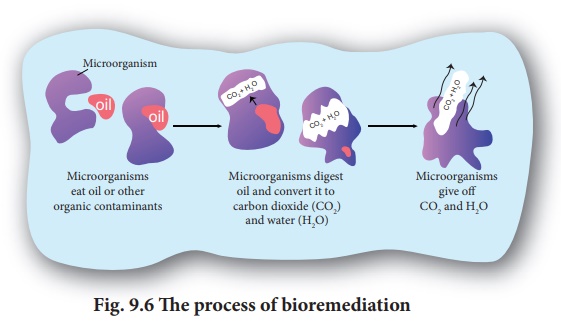Zoology - Bioremediation | 12th Zoology : Chapter 9 : Microbes in Human Welfare
Chapter: 12th Zoology : Chapter 9 : Microbes in Human Welfare
Bioremediation
Bioremediation
The use of naturally occurring or genetically engineered microorganisms to reduce or degrade pollutants is called bioremediation. Bioremediation is less expensive and more sustainable than other remediations available.
It is grouped into in situ bioremediation (treatment of contaminated soil or water in the
site) and ex situ bioremediation (treatment of contaminated soil
or water that is removed from the site and treated) .
Microorganisms involved in bioremediation
Aerobic microbes degrade the pollutants
in the presence of oxygen. They mainly degrade pesticides and hydrocarbons. Pseudomonas
putida is a genetically engineered microorganism (GEM). Ananda Mohan
Chakrabarty obtained patent for this recombinant bacterial strain. It is
multi-plasmid hydrocarbon-degrading bacterium which can digest the hydrocarbons
in the oil spills (Fig. 9.6).

Nitrosomonas europaea is also capable of degrading
benzene and a variety of halogenated organic compounds including
trichloroethylene and vinyl chloride. Ideonella sakaiensis is currently
tried for recycling of PET plastics (Fig. 9.7). These bacteria use
PETase and MHETase enzymes to breakdown PET plastic into terephthalic
acid and ethylene glycol.

Anaerobic microbes degrade the pollutants
in the absence of oxygen. Dechloromonas aromatica has the ability to
degrade benzene anaerobically and to oxidize toluene and xylene. Phanerochaete
chrysosporium an anaerobic fungus exhibits strong potential for bioremediation
of pesticides, polyaromatic hydrocarbons,dyes,trinitrotoluene, cyanides, carbon
tetrachloride, etc.,Microorganisms Dehalococcoides species are give o
responsible for anaerobic CO2 and H2O
bioremediation of toxic trichloroethenetonon- toxic ethane. Pestalotiopsis microspora is a species of endophyticfungus capable of
breaking down and digesting polyurethane. This makes the fungus a potential
candidate for bioremediation projects involving large quantities of plastics.
Related Topics